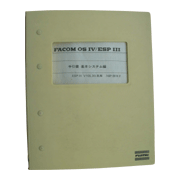OSIV/ESPIII (*) was Fujitsu’s medium-scale general-purpose operating system (hereinafter “OS”), and was announced in June 1984 as the OS for medium-scale computer systems that realized system OA (Office Automation). OSIV/ESPIII was developed to meet the demands of the expansion and advancement of information processing with enhanced “ease of use,” “ease of application development” and “function for linking the computer and the personal computer” (hereinafter “PC”).
The following describes the background to OSIV/ESPIII development, and the features and functional enhancements of OSIV/ESPIII.
*: ESPIII is an abbreviation of “Effective System Products III.”
Fujitsu provided a core computer system for OA (Office Automation) with OSIV/ESP V2 based on medium-scale general-purpose OS OSIV/F2. Meanwhile, remarkable progress had been taking place in computer hardware technologies. FACOM M-730, announced in March 1987, had expandability equivalent to that of large computers, such as a multiprocessor system for up to 4 CPUs and main memory of up to 45 MB. So the corresponding enhancement of OSIV/ESP V2 was expected. In addition, demand for the OA functions and the function for linking to PC and workstations was also growing with respect to large computers. OSIV/ESP V2 had already provided such function. To resolve these issues, Fujitsu developed OSIV/ESPIII, which allowed use of multiprocessor, 31-bit address support and a simple OS integration to the upper OS (OSIV/X8). In addition OSIV/ESPIII made it possible to use the common middleware programs in OSIV family.
As a result, the OSs for the M series at that time comprised three models: OSIV/F4 MSP, OSIV/X8 FSP and OSIV/ESPIII.
Medium-scale general-purpose OS OSIV/ESPIII had the following features:
To efficiently process extensive and ever-increasing office-related information, Fujitsu provided OAP (OA Products), which dramatically increased efficiency of office work processing in conjunction with the OA personal computer FACOM 9450-II, of which about 40,000 units had already been sold at that time.
OAP consisted of three products: OAP/BASE, OAP/SERVER and OAP/MAIL. These enabled effective use of PC information (management of the large volume of information in PCs by the host system, and information exchange between PCs), effective use of the host information (use of information accumulated through critical business operations and its shared use among sections) and effective use of host functions (large-volume printing using a high-speed printer, and fast information transmission via e-mail), thereby achieving increased efficiency in office operations.
By providing DSSIII (extended Decision Support System III), the OS extended the previous concept of decision-support processing for top executives. It meant that a wide variety of end users were supported for problem solving. DSSIII consisted of three products: DSSIII/MANAGER, DSSIII/ANALYST and DSSIII/ADVISER. It allowed the user to introduce systems in stages, from a practical and convenient system to a simulation level based on a business model.
By providing the following functions, the OS facilitated development and operation of mission critical business applications:
Effective use of diversified pieces of information in various business operations by organizing and integrating
Following the release of OSIV/ESPIII in June 1984, two major functional enhancements were announced. Support for a multiprocessor system of up to 4 CPUs was announced in March 1987, and expansion of the virtual memory space to 256 MB and expansion of the cover-range of CPU performance were announced in October 1988.
The office work processing function and relational type database, etc. for mission critical applications that had earlier been provided with OSIV/ESPIII were enhanced as products common to M series models and were also adapted to large-scale general-purpose OSs.
OSIV/ESPIII was succeeded by OS OSIV/XSP, which was announced in November 1990.
| Announcement date | Major features | Version/ Level | Shipment date |
|---|---|---|---|
| June 1984 |
・Announced as successor OS to medium-scale general-purpose OS OSIV/ESP V2
-Supported medium-scale general-purpose computers M-310E, 320E and 330E and M-340R, 340S and 340 -Supported magnetic disks incorporated with M-310E, 320E or 330E -OAP(OAP/Base,OAP/Server,OAP/Mail) -DSSIII -Support for DB/E III, ADAMS/E, Japanese-language JEFII and distributed processing network |
V10L10 | November 1984 |
| March 1987 |
・Enhancement of OSIV/ESPIII
-Supported multiprocessor systems consisting of up to 4 CPUs for medium-scale general-purpose computer M-730 model group ・Provision of products common to M series models
-Provided OCSF (OSI Communication Support Facility), compliant with OSI, an international standard -Provision of integrated network management system COMS, which managed communication devices in addition to the host computer and workstations in an integrated manner and realized a high-reliability network |
V10L20 | October 1987 |
| - |
・Functional enhancements of AIM V12 (common to OSIV/F4 MSP, OSIV/X8 FSP and OSIV/ESPIII)
-Support for presentation files (for integration of screen editing processing between TSS/AIF and AIM, sharing with the FACOM K series and the FACOM G series) -AP/EF(*1) and AP/DF(*2), which realized prototyping of simplified online applications and mission critical online applications -Integrated distribution support for slips: APS(*3) -High-level language COBOL 85, which supported a presentation file function ・Host-workstation linkage function LINKSERV
-DSM(*4),DRMS(*5),CJMS(*6),DTS(*7) |
V10L30 | June 1987 to December 1987 |
| October 1988 |
・Enhancements of OSIV/ESPIII
-Extended virtual memory space from 16 MB to 256 MB -Extended supported models to large-scale general-purpose computer FACOM 760/10, and covered performance up to approximately 14-fold with the same OS. -Enhanced relational type database DB/E III (dynamic definition function of logical files, delayed index maintenance function) |
V20L10 | June 1989 |
*2 AP/DF:Application Program Environment/Development Facility
*3 APS:Advanced Printing Subsystem
*4 DSM:Distributed System Manager
*5 DRMS:Distributed Resource Management Support
*6 CJMS:Computer Network Job Management System
*7 DTS:Data Transfer Service



